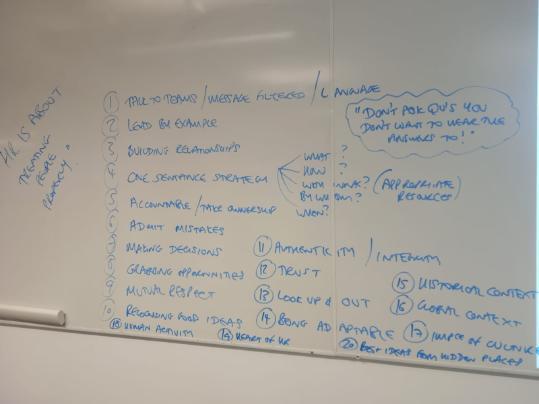Sharing leadership lessons for the next generation – part 2
Reflections from Charles Style CBE, our Guest Speaker on ‘Leadership’ following his Guest Speaker session on ‘Leading in Challenging Global Environment.’
Charles came to our Business School to speak to a joint guest lecture between MSc International Business Management and CIPD HR Diploma students in March 2022. He shared many leadership lessons on the day and the below is the second part of his reflections on a question from students on ‘how do you make a strategy real’ (to see the part 1)
-------------------------------------
The word strategy trips off the tongue; we know we need it in our work and in our lives. But what is it? What does good strategy look like? How do we deliver it?
Often, we see the word applied to a list of tasks, or an aiming point, or a set of aspirations, or a big idea. However, a strategy which is worth its name is more than any one of these on its own.
The essence is this: every strategy must have five elements: what are we going to do; by whom is it going to be done; with what resources, how and when. The essence is that a strategy must have contained within it the means of its delivery; otherwise, it’s just an aspiration.
The what is usually the aiming point and probably contains the core of a change. The by whom self-evidently must realistically define the commitment required of people – and the necessary resourcing - in relation to their current roles. Often organisations aspire to do something new, and never face up to the human capacity required. The result then is that neither the initiative nor people’s ‘day jobs’ receive adequate attention.
The with what resources heading is related; does the organisation need to invest in new IT, technology, skills, training, premises? The timescale implies a properly considered and defined timeline, identifying crucial dependencies; for example, in the plan to deliver a new strategy, there may be several main lines of action; is action c of one line dependent on completion of action b on another line. If so, are timings and resourcing compatible?
The how in a sense wraps all this together. It may imply the negotiation of a loan, or the reduction of part of the current business to release capacity. Then finally it must be possible to express the strategy and all its elements in one sentence. Why? Because inability to do this means – as night follows day - that the central idea (concept and delivery) hasn’t yet been adequately defined, and because – in this case – people in the business won’t be able to state clearly what either the strategy or their part in it is.
Make time to engage across the business. How often have you experienced the “that’s a VERY good point” reaction when chatting with someone in your team, quite probably informally. In a good corporate culture, people will be encouraged to speak out; even so, the intelligent PA, salesperson or IT specialist – all (let us say) junior in the hierarchy – may harbour excellent insights but lack the confidence or opportunity to air them.
To emphasise this point, if a toilet cleaner is told “I’m sorry, there are going to be a lot of blokes tramping through here in dirty boots, but it won’t last more than a fortnight – and this is your contribution to our new plant which will boost our competitiveness by x or y”, he or she may – probably will – feel proud, know the plan, and know his or her part in it. A good idea might come out of it: ‘why not relocate the firefighting equipment while you’re at it; it’s badly placed and inefficient. You could avoid the need for that separate building’.
There is one more element; it is to do with clarity of understanding at all levels. When the senior leader is happy the strategy is formed, it is essential to convene a meeting of all the key players. The boss lays out the plan, seeks questions and comment, and then sends them off to their own teams to explain the plan and refine detail. Good so far! But not good enough.
The boss should then recall the key players, and invite them to play back their parts in the plan and their intentions for delivering it. This always reveals errors of understanding and inconsistencies. This does not result from stupidity, but from the extreme difficulty of expressing or hearing a plan in such a way that no misunderstanding creeps in. “This cat is blue” can be heard as “that dog is red”! Strange but true.
Then the boss must restate the strategy, adjust instructions where necessary, and send his team leaders away to re-run the process. It usually takes at least three pulls of this handle to achieve clarity and consistency between teams and with the boss; all will be motivated, and good ideas are certain to have been revealed. And yet this often doesn’t happen because of pressure of time. The ‘we’re up against our deadline’ mantra is a common reason for failure of strategy at the last fence.
Good luck!
End
The photo is a debrief of what we discussed on that day!

Any queries on the blog, the guest speaker or the session, please contact Dr Eun Sun Godwin (e.godwin@wlv.ac.uk) and Dr Jenni Jones (jenni.jones@wlv.ac.uk)


/prod01/wlvacuk/media/departments/digital-content-and-communications/images-18-19/iStock-163641275.jpg)
/prod01/wlvacuk/media/departments/digital-content-and-communications/images-2024/250630-SciFest-1-group-photo-resized-800x450.png)
/prod01/wlvacuk/media/departments/digital-content-and-communications/images-18-19/210818-Iza-and-Mattia-Resized.jpg)
/prod01/wlvacuk/media/departments/digital-content-and-communications/images/Maria-Serria-(teaser-image).jpg)
/prod01/wlvacuk/media/departments/digital-content-and-communications/images-2024/241014-Cyber4ME-Project-Resized.jpg)
/prod01/wlvacuk/media/departments/digital-content-and-communications/images-18-19/210705-bric_LAND_ATTIC_v2_resized.jpg)